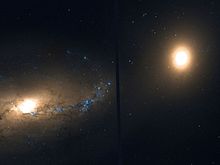- NGC 3226
-
NGC 3226 
NGC 3227 and NGC 3226Observation data (J2000 epoch) Constellation Leo (constellation) Right ascension 10h 23m 27.0s[1] Declination +19° 53′ 55″[1] Redshift 1151 ± 10 km/s[1] Type E2 pec[1] Apparent dimensions (V) 3′.2 × 2′.8[1] Apparent magnitude (V) 12.3[1] Other designations UGC 5617,[1] PGC 30440,[1] Arp 94[1] See also: Galaxy, List of galaxies NGC 3226 is a dwarf elliptical galaxy that is interacting with the spiral galaxy NGC 3227. The two galaxies are one of several examples of a spiral with a dwarf elliptical companion that are listed in the Atlas of Peculiar Galaxies.[2] Both galaxies may be found in the constellation Leo.
Contents
Nucleus
NGC 3226 contains a low-ionization nuclear emission-line region (LINER), a type of region that is characterized by spectral line emission from weakly ionized atoms.[3] In general, the energy source for LINER emission has been a subject of debate among astronomers. Some astronomers have asserted that LINERs are powered by star formation regions, while other have asserted that LINERs are powered by active galactic nuclei (AGN) which contain supermassive black holes.
AGN
The nucleus of NGC 3226 appears to contain an AGN. The nucleus is a strong source of both radio[4][5] and X-ray[6] emission that appears to be synchrotron emission, which is generated when electrons moving at high speeds oscillate within magnetic fields. Such synchrotron emission is expected from the environment around a supermassive black hole. The X-ray emission may also be variable, which is also expected in the environment of a supermassive black hole.[6]
Interstellar medium
It is possible that NGC 3226 may be acquiring gas from NGC 3227 during the interaction process, which would enhance star formation within NGC 3226. However, millimeter observations of NGC 3226 failed to detect any molecular gas within the galaxy. These results not only demonstrate that NGC 3226 contains little molecular gas but also demonstrate that the galaxy has acquired no gas from NGC 3227.[7]
External links
- NGC 3226 on WikiSky: DSS2, SDSS, GALEX, IRAS, Hydrogen α, X-Ray, Astrophoto, Sky Map, Articles and images
References
- ^ a b c d e f g h i "NASA/IPAC Extragalactic Database". Results for NGC 3226. http://nedwww.ipac.caltech.edu/. Retrieved 2007-01-14.
- ^ H. Arp (1966). "Atlas of Peculiar Galaxies". Astrophysical Journal Supplement 14: 1–20. Bibcode 1966ApJS...14....1A. doi:10.1086/190147.
- ^ L. C. Ho, A. V. Filippenko, W. L. W. Sargent (1997). "A Search for "Dwarf" Seyfert Nuclei. III. Spectroscopic Parameters and Properties of the Host Galaxies". Astrophysical Journal Supplement 112 (2): 315–390. arXiv:astro-ph/9704107. Bibcode 1997ApJS..112..315H. doi:10.1086/313041.
- ^ N. M. Nagar, H. Falcke, A. S. Wilson, L. C. Ho (2000). "Radio Sources in Low-Luminosity Active Galactic Nuclei. I. VLA Detections of Compact, Flat-Spectrum Cores". Astrophysical Journal 542 (1): 186–196. arXiv:astro-ph/0005382. Bibcode 2000ApJ...542..186N. doi:10.1086/309524.
- ^ H. Falcke, N. M. Nagar, A. S. Wilson, J. S. Ulvestad (2000). "Radio Sources in Low-Luminosity Active Galactic Nuclei. II. Very Long Baseline Interferometry Detections of Compact Radio Cores and Jets in a Sample of LINERs". Astrophysical Journal 542 (1): 197–200. arXiv:astro-ph/0005383. Bibcode 2000ApJ...542..197F. doi:10.1086/309543.
- ^ a b I. M. George, R. F. Mushotzky, T. Yaqoob, T. J. Turner, S. Kraemer, A. F. Ptak, K. Nandra, D. M. Crenshaw, H. Netzer (2001). "X-Ray Emission from the Nucleus of the Dwarf Elliptical Galaxy NGC 3226". Astrophysical Journal 559 (1): 167–172. arXiv:astro-ph/0105083. Bibcode 2001ApJ...559..167G. doi:10.1086/322389.
- ^ H. Cullen, P. Alexander, M. H. Clemens (2006). "Gas in early-type galaxies: cross-fuelling in late-type-early-type pairs?". Monthly Notices of the Royal Astronomical Society 366 (0): 49–57. Bibcode 2006MNRAS.366...49C. doi:10.1111/j.1365-2966.2005.09662.x.
Categories:- Elliptical galaxies
- Dwarf elliptical galaxies
- Peculiar galaxies
- LINER galaxies
- Leo constellation
- NGC objects
- UGC objects
- PGC objects
- Arp objects
Wikimedia Foundation. 2010.
